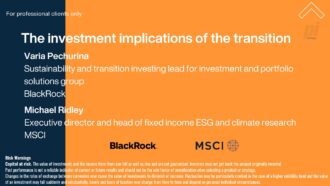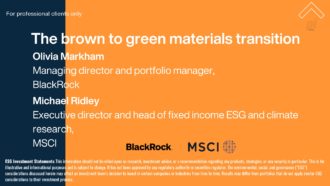T. Rowe Price fixed income portfolio manager Samy Muaddi explains what he looks for when assessing EM debt, Asia’s influence, ESG and the end of the credit cycle.
What factors do you consider when looking at emerging market debt?
In our framework, we start with sovereign vulnerability. There is a 200-year historical record of the emerging debt market and a lot of symmetry in the causes of sovereign crises.
There are four parts to our framework. The first is fiscal risk, which is the traditional overspending of governments, inclusive of borrowing in foreign currency. The second is the external factors. By necessity these countries are capital importers and when the tide of risk sentiment changes it leaves them more vulnerable, irrespective of their policy mix. Usually, bad policy is exposed in those periods of capital outflow.
The third is contingent liabilities. These are factors that happen usually off the sovereign balance sheet but become a sovereign risk. The most recent version of that is a banking sector issue, which becomes a fiscal cost at the backend. It could also happen in other state-owned enterprises, or in the pensions industry.
The last piece of it is politics, which we cannot escape. We have a unique angle there. The market focuses too much on people and we are not capable of evaluating a person’s intentions. In 1998, for example, Hugo Chávez of Venezuela was considered a reformer and was invited to ring the bell at the New York Stock Exchange. Rather than focus on the headlines of the day, what we focus on from a political angle is what leadership does to institutions.
Institutions are the durable piece that follow a given leader. That is the piece that matters more from a capital markets perspective, not the headline of the day. We have a consistent framework. It is built on our 40 years of emerging market investing and on a survey of a near 200-year track record of emerging market sovereign debt issuance.
Can Chinese stimulus be relied upon to offset the next global slowdown?
I would label this the “China put”. We have lived through abnormal times in the past 10 years. QE gets a lot of press, as it should, but larger monetary stimulus has come through Chinese credit creation. There is $32trn (£26.3trn) of Chinese credit outstanding, which is around 40% of global GDP.
China’s ability to manage this is not the issue, what I am concerned about is that China has reflated the world in many periods of risk aversion. If you look at the 30-year treasury yield as a proxy for inflation, every time you had an increase in that yield it was caused by or coincided with Chinese money supply growth.
My concern is that we are at a point where money supply outstanding is so high that it limits China’s ability to print more. Then there are funding constraints in the economy that were not evident five to seven years ago.
In our industry, we transact in probabilities not certainties. What I would say with conviction is that the probability of that stimulus is lower than it has been in the past decade. Even if we get a stimulus, the reflationary benefits of it would be lower than in previous periods because of the amount that has been done already.
Why is Asia important in this market?
Asia credit is the best performing part of emerging markets on a risk-adjusted basis. It has the highest sharpe ratio relative to Latin America and CEEMEA credit because Asia has saving rates of around 40%. It is not just foreigners supporting the bond market, locals are too, so it behaves better during periods of risk aversion.
Secondly, Asia credit has accounted for more than 100% of net supply in the past five years. It is growing as a share of the debt market. In the 1990s Asia credit was roughly 5% of the market; today it is more than 50%.
If we are coming to the end of the credit cycle, who will survive and who will not?
The good news is that the emerging credit cycle started five years ago. We have already seen South Africa, Brazil, Russia and Turkey downgraded to high yield. EM currencies have experienced up to 40% depreciation during that period. We are much earlier to the adjustment and a lot of the bad news is already in the price.
The US economy, which is in a later cycle, has not had the adjustment that we have gone through in the past five years.
Corporate ESG disclosure is improving, but what more needs to be done?
Emerging market investors were doing ESG integration before ESG was a term. This is something that is indigenous to our asset class. If you want to succeed in our asset class ESG is essential. For example, in the 1970s there was divestment from South Africa due to the policies imposed by the government at the time. We are entering complexities. This is not a business where you can focus exclusively on financial metrics. We, as investors, are solving the complex challenges of society, business, politics, culture and environment.




